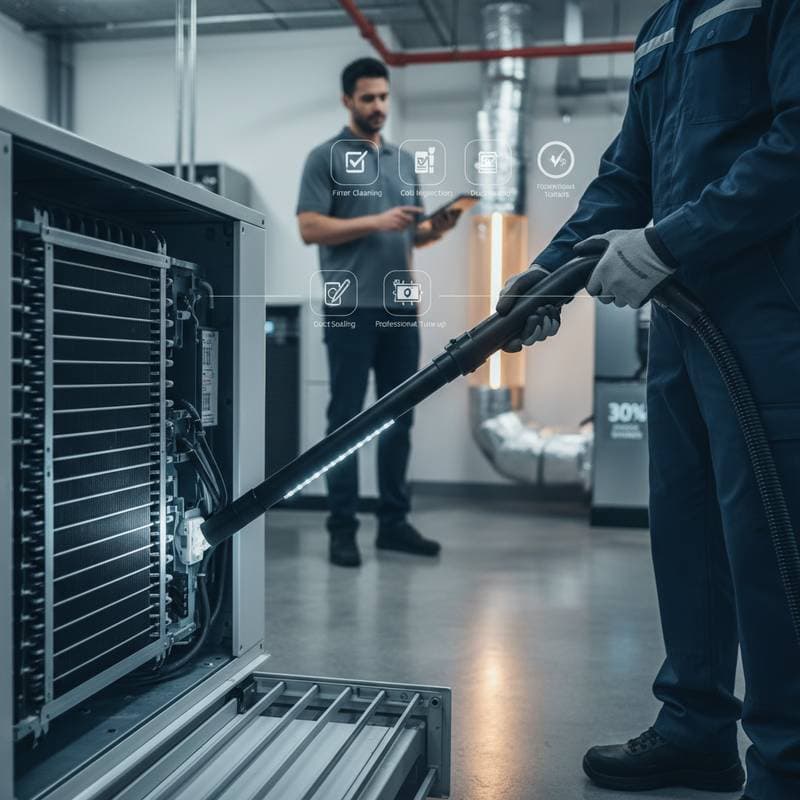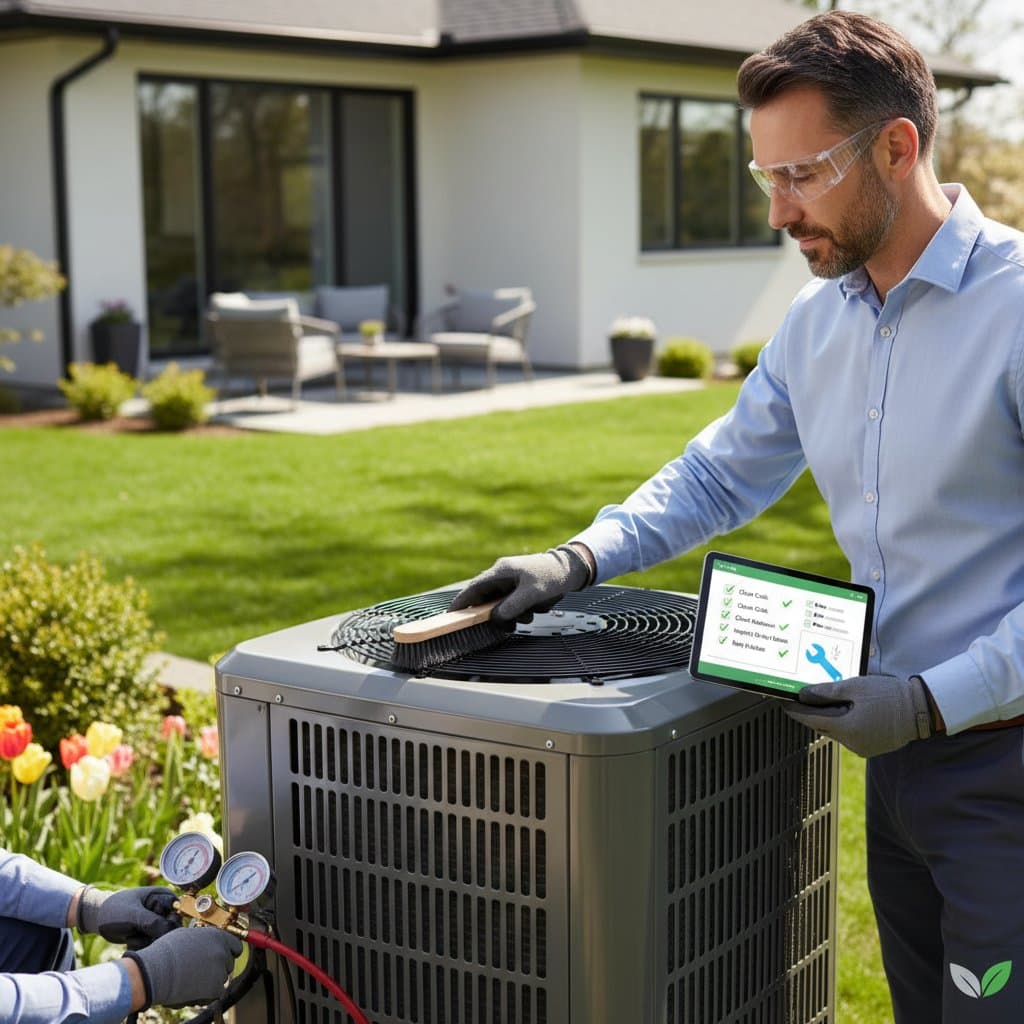Prepare Your AC Early for a Cool, Cost-Saving Summer
A comfortable home during summer relies on a dependable air conditioner. Numerous homeowners delay maintenance until the initial heat wave strikes, which often results in elevated bills and unforeseen failures. Early preparation of your AC system prevents expensive repairs and manages energy consumption effectively. A properly maintained system operates up to 30 percent more efficiently.
This guide provides a comprehensive, practical checklist to ready your air conditioner before the warm weather arrives. Each step explains inspections, tasks you can handle independently, and situations that require professional assistance.
Conduct a Visual Inspection
Start with the outdoor unit. Remove leaves, grass, and debris surrounding the condenser. Maintain at least two feet of clearance on all sides to ensure adequate airflow. If plants or fencing encroach closer, trim or relocate them to enhance circulation.
Examine for evident problems such as bent fins, loose screws, or rust. Bent fins impede airflow and diminish cooling effectiveness. Gently straighten them with a fin comb, available for approximately ten dollars at hardware stores.
Inside the home, check vents and registers. Ensure furniture or rugs do not obstruct airflow. A blocked vent leads to uneven cooling and compels the system to labor excessively.
Replace or Clean Filters
Dirty filters represent the primary cause of diminished efficiency and increased cooling expenses. They limit airflow and capture dust that accumulates on coils. Replace disposable filters every one to three months, based on usage. Clean washable filters meticulously and dry them before reinstallation.
A standard filter ranges from ten to twenty dollars, while high-efficiency options cost about forty dollars. This expenditure yields savings on energy bills and purer indoor air. For homes with pets or allergy sufferers, consider HEPA or electrostatic filters for improved results.
Verify Thermostat Settings
The thermostat regulates system operation frequency. Test it to confirm accurate response. Switch to cooling mode and set the temperature several degrees below the room level. The AC should activate within one to two minutes.
If the thermostat includes programmable or smart capabilities, evaluate the configurations. Program higher temperatures during unoccupied periods and lower them prior to your return. Smart thermostats lower cooling costs by up to ten percent each year.
Replace batteries if applicable, or inspect wiring for corrosion or loose connections.
Examine the Condensate Line and Drain Pan
The condensate line removes moisture from the evaporator coil. Clogs cause water backup, leading to leaks or mold. Locate the drain line near the indoor unit and pour one cup of distilled white vinegar into it to dissolve algae or mineral deposits.
Check the drain pan beneath the coil for cracks or pooled water. Clean the pan with mild soap and verify drainage. For stubborn clogs, use a wet-dry vacuum to clear the line from the exterior end.
Clogged condensate lines rank among the most frequent issues technicians address, but seasonal cleaning prevents them easily.
Inspect and Clean the Coils
Evaporator and condenser coils gather dust and grime over time. This layer insulates the coils, impairing heat absorption and release.
Disconnect power to the system before cleaning. For the outdoor unit, detach the top grille and brush debris from the fins lightly. Apply coil cleaner spray, priced at about ten dollars, and rinse with a garden hose on low pressure. Take care not to bend the fins.
For the indoor evaporator coil, employ a soft brush or vacuum attachment. If access proves difficult, hire a licensed technician for thorough cleaning during a tune-up. Such services cost between one hundred and one hundred fifty dollars, varying by system size.
Tighten Electrical Connections and Inspect Components
Loose connections produce voltage drops that overheat components and reduce longevity. With power disabled, access the panel and identify wear indicators like darkened terminals or melted insulation. Secure visible screws and reattach loose wires cautiously.
Inspect the capacitor and contactor for damage. A swollen capacitor or eroded contactor hinders compressor startup. These parts cost under fifty dollars apiece, but replacement demands expertise. Engage a qualified technician for electrical work to ensure safety.
Lubricate Moving Parts
Certain older air conditioning units feature motors and fan bearings needing lubrication. If oil ports exist, apply a few drops of manufacturer-recommended oil to each. Avoid overfilling. Modern units typically use sealed bearings that require no lubrication.
Lubrication minimizes friction, noise, and motor stress. If the fan motor emits squeals or hums, this maintenance may resolve the issue before it escalates to costly repairs.
Schedule a Professional Tune-Up
Despite diligent upkeep, professional evaluation each season guarantees safe, optimal performance. Technicians assess refrigerant levels, airflow, controls, and thermostat calibration.
Homeowners who arrange yearly tune-ups incur fewer emergency repair expenses and prolong system life by years. A complete AC tune-up averages one hundred to two hundred dollars and encompasses cleaning, pressure checks, and a performance report.
Seal and Insulate Ductwork
Leaky ducts squander up to 30 percent of cooled air before it arrives in living spaces. Examine visible ducts in attics or basements for gaps, unsecured joints, or absent insulation.
Apply mastic sealant or foil tape to seal leaks securely. Wrap uninsulated sections with fiberglass duct insulation to retain cool air and boost efficiency. Professional duct sealing, if needed, costs two hundred to five hundred dollars but delivers rapid payback through energy savings.
Test for leaks by observing dust patterns at registers or using a duct blaster tool during a pro inspection. Proper sealing ensures even cooling distribution and reduces strain on the AC.
Essential Tips for Optimal Performance
-
Test the system early. Operate the air conditioner prior to the first warm day to verify effective cooling. This approach allows time for repairs without peak-season delays.
-
Inspect refrigerant lines. Confirm insulation on copper lines remains intact. Replace degraded or absent sections to avoid energy loss.
-
Incorporate ceiling fans. Fans circulate cool air evenly, permitting a higher thermostat setting while preserving comfort.
-
Provide shade for the outdoor unit. Erect an awning or position shrubs to shield from direct sun, while preserving two feet of airflow clearance.
-
Track utility bills. An abrupt rise indicates inefficiency or concealed problems, prompting timely action.
Achieve Lasting Efficiency and Comfort
Routine AC preparation transforms summer from a burden into a breeze. By following these steps, you safeguard your system, trim expenses, and enjoy consistent cooling. Invest time now to reap rewards all season, ensuring your home stays refreshingly cool without surprises.





